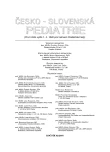Familial Hypobetalipoproteinemia
Authors:
Š. Rosipal
Authors‘ workplace:
Metabolická ambulancia Lipmet s. r. o.
Published in:
Čes-slov Pediat 2007; 62 (7-8): 434-439.
Category:
Original Papers
Overview
The paper reviews the genetics and pathobiochemistry of familial hypobetalipoproteinemia, its clinical manifestation and complications. Familial hypobetalipoproteinemia represents an autosomal dominant disorder in the formation of hepatic apolipopediatrie protein B, which plays a key role in the metabolism of lipoproteins. The prevailing genetic mutations include frameshift and nonsense changes with a frequent localization on chromosome 2, rarely localized on chromosome 3. The third type of alteration does not display association with the loci mentioned above. The metabolic disorder becomes manifest in the formation of truncated forms of the protein chain. The diagnosis is based on very low levels of LDL cholesterol and apolipoprotein B in serum, which are usually less than 5 percentile according to age and sex. Abnormal biosynthesis of apolipoprotein B affects the export system of atypical VLDL particles and can thereby result in fat accumulation in the liver. Liver steatosis displays considerable individual differences and relation to the body mass index, intraperitoneal fat and insulin resistance. Reduction of atherogenic components in the lipidogram probably decreases the risk of cardiovascular lesions.
The group of patients consisted of 39 individuals with heterozygous type of the disease. These individuals included 22 children and adolescents at the mean age of 14.5 years (range 7 to 18). In two cases there was liver steatosis (detected by ultrasound) and a mild increase in aminotransferase values. The frequency of familial hypobetalipoproteinemia was around 0.07% and the concentration of normal apolipoprotein B in plasma was 30% of physiological values. A compulsory universal screening for risk factors in cardiovascular diseases at the child and juvenile age, including the determination of c. cholesterolemia will increase the number of patients with this metabolic defect in Slovakia.
Key words:
familial hypobetalipoproteinemia, apolipoprotein B, truncated chains of apolipoprotein B, liver steatosis
Labels
Neonatology Paediatrics General practitioner for children and adolescentsArticle was published in
Czech-Slovak Pediatrics

2007 Issue 7-8
Most read in this issue
- Rethore Syndrome (Trisomy 9p)
- Individualized Protein Fortification of Human Breast Milk in Newborns of Lower Birth Weight: the Key for Decreasing Morbidity?
- Familial Hypobetalipoproteinemia
- Variable Manifestation of Dystrophic Curschmann-Steinert Myotonia as a Result of Genomic Imprinting
